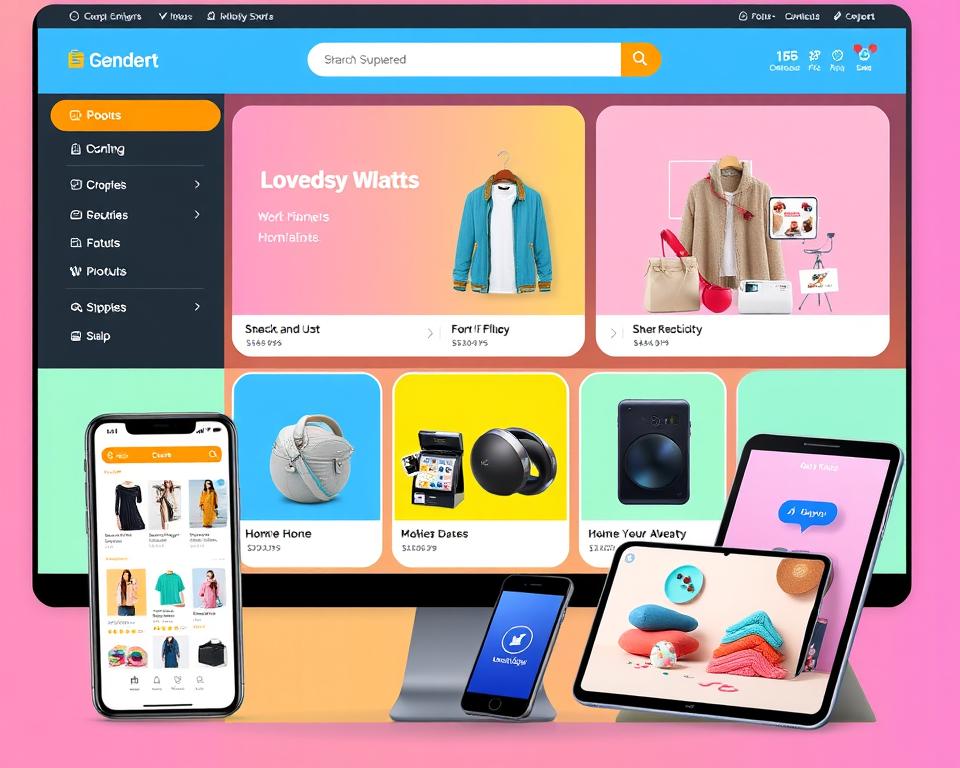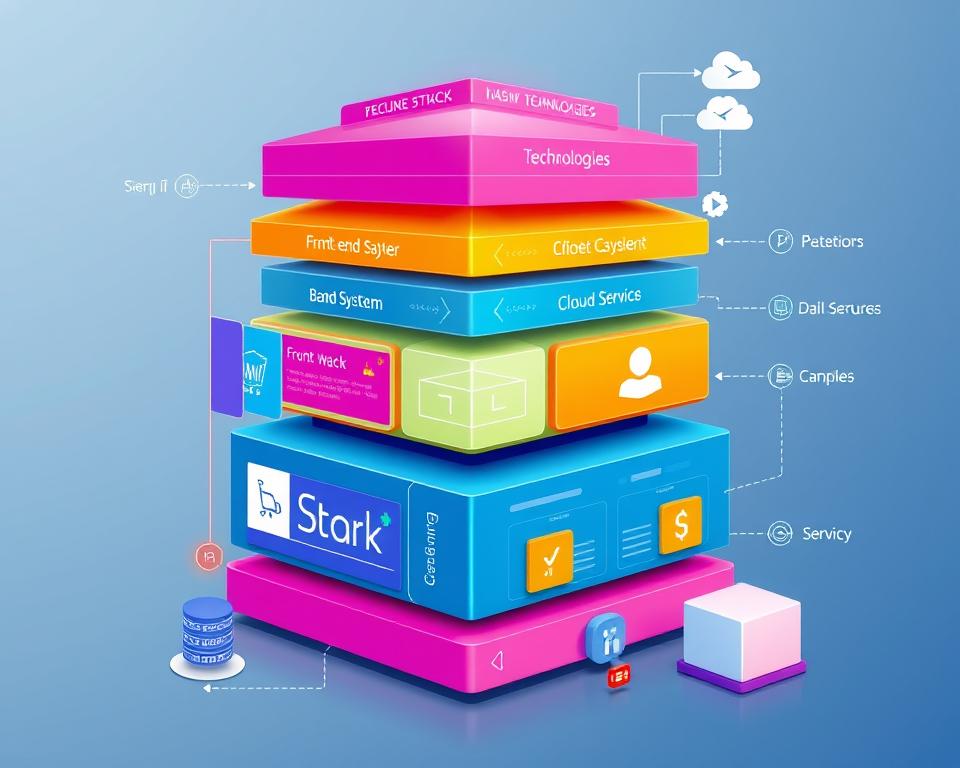The world of e-commerce is changing fast. Businesses of all sizes want to make a strong online presence. Shopify is a top choice for easy and growing online stores. Many companies want to create their own app like Shopify.
This article covers the main features, technical needs, and how to make an e-commerce app like Shopify. It’s for anyone wanting to start a business, own a small business, or be a software developer. You’ll learn how to build a successful online store app for your customers.
Table of Contents
Key Takeaways
- Understand the essential features and capabilities of a Shopify-like online store app.
- Explore the current e-commerce market trends and identify key players in the industry.
- Discover the technical requirements and architecture necessary for building a robust e-commerce platform.
- Learn about the various frontend technologies, backend frameworks, and database solutions to support your app development.
- Gain insights into user authentication, security, and payment gateway integration for a seamless customer experience.
Understanding the E-commerce App Development Landscape
The e-commerce market is changing fast, offering both challenges and chances for businesses. It’s key to know the current trends, major players, and business models in the e-commerce world.
Current Market Trends and Opportunities
The e-commerce market trends show a focus on mobile-friendly shopping, personalization, and smooth online and offline shopping. With more people shopping on their phones and tablets, apps need to be easy to use. Businesses must keep up with these changes to stay ahead.
Key Players in E-commerce Platform Space
Big names like Shopify, WooCommerce, and Magento lead the e-commerce platform world. They offer different features and strengths. It’s important to compare these to find the best fit for your business.
Business Model Analysis
E-commerce platforms use various business models, like subscriptions or commissions. Understanding these can help you see how they make money and set prices. This knowledge can guide your own business strategy and help your e-commerce app succeed.
“The e-commerce industry is undergoing a transformative shift, driven by evolving consumer preferences and the rapid advancement of mobile technologies. Businesses that can adapt to these changing dynamics will be well-positioned to thrive in this dynamic landscape.”
Essential Technical Requirements for Shopify-like Platform
Creating a strong e-commerce platform like Shopify needs careful thought about technical specs and system needs. To build a scalable and dependable setup, e-commerce sites must focus on several key areas. These areas form the base of their e-commerce infrastructure.
First, the server setup is crucial. Businesses must have a reliable, high-performance web server. This server should handle more traffic and transactions during busy times. It also needs to support the platform’s technical specifications and system requirements, like database management and payment processing.
Scalability is also key when designing a Shopify-like platform. As the business grows, the platform must handle more technical specifications and system requirements smoothly. This means using efficient caching, load balancing, and distributed computing.
| Feature | Technical Requirement | Benefit |
|---|---|---|
| High-performance Server | Powerful CPU, ample RAM, and fast storage | Ensures smooth operation and handles increased traffic |
| Scalable Infrastructure | Modular design, load balancing, and cloud-based resources | Enables the platform to scale up or down as needed |
| Robust Database | Highly available, secure, and optimized for e-commerce data | Provides efficient data storage and retrieval for products, orders, and customers |
By focusing on these key technical needs, businesses can create a Shopify-like platform. This platform will be feature-rich, scalable, reliable, and ready for a thriving e-commerce site.
Core Architecture and Technology Stack Selection
Building a strong e-commerce platform like Shopify needs a solid tech stack. This stack should link frontend, backend, and database smoothly. For frontend development, React and Vue.js are top picks. They’re known for their efficient performance and wide range of tools.
On the backend, Node.js and Ruby on Rails are favored. They’re scalable and offer many features. This makes them great for different development needs.
For the database, SQL options like MySQL and PostgreSQL are strong. NoSQL choices like MongoDB also offer great data management. The right database depends on the data type, scalability, and app needs.
Frontend Technologies
- React: A JavaScript library for building user interfaces, known for its virtual DOM and component-based approach.
- Vue.js: A progressive JavaScript framework that emphasizes simplicity, performance, and flexibility in frontend development.
Backend Framework Options
- Node.js: A JavaScript runtime environment that enables server-side development with its event-driven, non-blocking I/O model.
- Ruby on Rails: A popular web application framework written in Ruby, praised for its emphasis on convention over configuration and rapid development.
Database Solutions
| Database | Type | Key Features |
|---|---|---|
| MySQL | SQL | Widely used, scalable, and reliable; supports complex queries and transactions. |
| MongoDB | NoSQL | Flexible schema, high performance, and easy scalability for handling large amounts of unstructured data. |
Choosing the right tech stack is key for a smooth e-commerce platform. It ensures a scalable, secure, and feature-rich app. For more on tech stacks, see this article: Everything You Want to Know About Tech Stack for Your Web Development.
User Authentication and Security Features
In today’s digital world, strong user authentication and data security are key for e-commerce success. Online stores handle personal and financial info, making it vital for app developers to use encryption, SSL certificates, and other security measures. This protects user data and transactions.
A secure e-commerce platform starts with a solid user authentication system. This might include username and password, two-factor authentication, biometric checks, or social media login. Strong encryption and following industry standards help keep user info safe from hackers.
- Use top encryption like AES, RSA, or SHA-256 to protect data in transit and storage.
- Get SSL certificates to create a secure link between users and the platform.
- Use secure ways to store and hash passwords to keep user credentials safe.
- Offer two-factor authentication, like SMS, email, or authenticator apps, for extra security.
By focusing on user authentication and data security, e-commerce app developers can earn trust and keep customers. These strong security steps not only protect user info but also show a commitment to handling data responsibly. This is crucial for the success and reputation of the e-commerce platform.
“Protecting customer data should be the top priority for any e-commerce business. Investing in robust security features is not just a necessity, but a competitive advantage that can set your platform apart.”
Product Management System Development
Creating a strong product management system is key for e-commerce sites like Shopify. It includes managing categories, controlling inventory, and handling different product types. Let’s explore each part to see why they’re important for a Shopify-like app.
Category Management
A good category management system is the base of a solid product catalog. It lets merchants sort their products into clear categories. This makes it easier for customers to find what they need.
Features like nested categories and custom attributes are important. They help manage how products are shown and found in each category.
Inventory Control
Good inventory management is vital for online stores. It includes tracking stock in real-time and sending alerts when it’s low. It also helps manage SKU data.
By giving merchants a clear view of their stock, the app helps them avoid running out of items. It also helps them plan their supply chain better.
Product Variation Handling
Online stores often have products with different variants, like sizes or colors. A flexible system to handle these variations is crucial. It should include features like pricing for each variant and tracking inventory.
It should also let merchants create their own product options and combinations. This makes managing different products easier.
| Feature | Benefit |
|---|---|
| Category Management | Organize products into logical categories, improve discoverability |
| Inventory Control | Real-time inventory tracking, SKU management, prevent stockouts |
| Product Variation Handling | Manage product variants and custom options, track product catalog |
By building a detailed product management system, e-commerce sites can give merchants the tools they need. These tools help manage their product catalog, inventory management, and product variants.
Shopping Cart and Checkout Implementation
Creating a smooth shopping cart and checkout process is key for a better user experience. It also helps in boosting sales. By making these steps easy, online stores can make customers happier and more likely to buy.
The shopping cart is a crucial part of the shopping journey. It should let customers add items easily, see what they’ve picked, and change their mind if needed. Features like real-time updates and clear order totals make the experience better.
The checkout process is also vital. A simple and clear checkout flow can greatly improve sales. Offering various payment methods, guest checkout, and easy form filling are important. Also, adding security features and trust signs can ease customers’ worries.
| Feature | Importance | Implementation Recommendations |
|---|---|---|
| Shopping Cart Functionality | High |
|
| Checkout Process | High |
|
By improving the shopping cart and checkout, online stores can offer a better experience. This leads to more sales. Keeping these areas up to date is important for staying competitive.
“Streamlining the shopping cart and checkout process is essential for converting browsers into buyers and driving sustainable business growth.”
Payment Gateway Integration and Processing
E-commerce is growing fast, making a good payment gateway system key for online stores like Shopify. This part talks about how to pick the right payment gateway. It’s all about making sure your customers can pay easily and safely.
Popular Payment Methods
It’s vital to offer many payment options to meet your customers’ needs. Here are some common ones:
- Credit and debit cards (Visa, Mastercard, American Express, Discover)
- Digital wallets (Apple Pay, Google Pay, Samsung Pay)
- Buy now, pay later options (Affirm, Afterpay, Klarna)
- Direct bank transfers and eChecks
Security Standards
Keeping payments safe is a top priority. You must follow PCI DSS compliance rules. This protects your customers’ financial info and builds trust in your site.
Transaction Management
Managing transactions smoothly is key for a good checkout experience. You need multi-currency support for global customers. Also, strong fraud prevention is crucial to stop unauthorized payments.
“Integrating a secure and versatile payment gateway is a crucial step in creating a Shopify-like e-commerce platform that inspires customer confidence and drives sales.”
Thinking about these payment details helps you create a solid payment system. It makes your online store better and helps it grow.
Order Management and Fulfillment System
An efficient order processing, shipping integration, and fulfillment automation system is vital for e-commerce success. It ensures a smooth customer experience and streamlines business operations. A strong order management and fulfillment system is essential.
The core of this system is order processing. It quickly handles incoming orders, checks them, and gets them ready for shipping. Working with shipping carriers and logistics providers makes order tracking automatic. This keeps customers updated on their orders.
Adding warehouse management and inventory control makes the fulfillment process better. It automates picking, packing, and shipping. This makes operations more efficient, cuts down on mistakes, and avoids delays.
- Streamlined order processing for quick turnaround
- Seamless shipping integration with leading carriers
- Automated fulfillment workflows for improved productivity
- Real-time order tracking and delivery updates
Using these advanced order management and fulfillment tools, e-commerce sites can offer great customer experiences. This boosts loyalty and helps businesses grow in the competitive online world.
How to Build an Online Store App Like Shopify: Key Features
Creating an e-commerce platform like Shopify requires a wide range of features. These features should meet the needs of online sellers. It’s important to balance user experience with the functionality of the app.
Must-have Features
- Intuitive product management system for seamless category organization, inventory control, and product variation handling
- Robust shopping cart and checkout process to streamline the purchasing journey for customers
- Secure payment gateway integration with support for popular payment methods and transaction management
- Efficient order management and fulfillment system to ensure smooth post-purchase experiences
Advanced Capabilities
To compete in the fast-changing e-commerce world, advanced features are crucial. These features improve the app’s functionality and user experience. Some examples include:
- Comprehensive analytics and reporting dashboard for data-driven decision making
- Seamless integration with third-party services and APIs for extended functionality
- Responsive and mobile-optimized design for optimal user experience across devices
Customization Options
Letting merchants customize their stores is key. Offering various customization options, like themes and branding, helps users create unique shopping experiences. This makes their stores stand out.
| Feature | Description | Importance for User Experience |
|---|---|---|
| Product Management | Robust tools for managing products, inventory, and variations | Enables merchants to efficiently organize and showcase their offerings |
| Checkout Process | Streamlined and secure checkout experience for customers | Reduces friction and abandonment during the purchase journey |
| Customization | Flexible options for branding, theming, and app integration | Allows merchants to create a unique and differentiated online store |
By including these features, a Shopify-like app can offer a full e-commerce solution. It meets the needs of today’s online sellers and improves the user experience.
Mobile App Development Considerations
Mobile devices are now the top choice for online shopping. Businesses aiming to create a Shopify-like platform must focus on mobile app development. This is key to meet the rising demand for mobile e-commerce.
Responsive design is a must. A website that works well on all devices is essential for a good user experience. Progressive web apps (PWAs) are a great option. They offer the ease of a website and the features of a native app.
On the other hand, native mobile apps provide a richer experience. They use device-specific features like push notifications and camera access. This makes shopping better for customers.
- Make sure your platform is mobile-friendly with a responsive design or a PWA
- Think about native mobile apps for a more immersive shopping experience
- Know your audience and their device preferences to choose the best app strategy
By understanding the pros and cons of different mobile app options, businesses can offer a smooth shopping experience. This meets the needs of today’s mobile shoppers.
Analytics and Reporting Dashboard
Data is key in e-commerce, driving smart choices. A good analytics and reporting dashboard is essential. It helps businesses track sales, understand customer behavior, and measure important KPIs accurately.
Sales Analytics
The dashboard’s sales analytics part should show your business’s income clearly. It gives detailed reports on product sales, conversion rates, and sales trends. With e-commerce analytics, you can find your best-selling items, spot growth areas, and improve sales strategies.
Customer Behavior Tracking
Knowing your customer’s path is vital for a better experience and loyalty. The dashboard’s data visualization tools help track customer actions. This includes browsing habits, cart abandonment rates, and repeat buys. Such KPI tracking data helps refine marketing and products to meet customer needs.
Performance Metrics
The dashboard’s business intelligence should give a full view of your platform’s performance. It should show website traffic, conversion rates, average order value, and customer lifetime value. This makes it easy to spot improvement areas and make informed decisions for growth.
Adding a strong analytics and reporting dashboard to your platform opens up a world of insights. It helps you make strategic, data-backed choices to boost your e-commerce business.
Third-party Integrations and API Development
In the fast-paced world of e-commerce, integrating with third-party services and creating strong APIs is key. Using API integration and connecting with a wide app ecosystem boosts platform features. It also makes customer experiences better and increases extensibility.
A Shopify-like platform’s open design makes it easy to link with many third-party services. This includes payment systems, shipping, marketing tools, and CRM solutions. With a wide range of integrations, the platform meets the varied needs of merchants. This lets them create a custom e-commerce site.
Also, a well-built API opens up more possibilities. A strong API lets third-party developers make custom apps that work well with the main platform. This app ecosystem adds special features, like inventory management and analytics. It makes the platform more useful and extensible.
To make third-party integrations and API development successful, the platform should focus on a few things:
- Wide integration options, supporting many popular third-party services
- A developer-friendly API with clear guides, SDKs, and example code for easy use
- Strong security, including safe authentication and data encryption, to protect data
- Smooth data sharing and updates between systems, for a better user experience
By focusing on these areas, a Shopify-like platform gives merchants the flexibility and customization they need. It also encourages a lively app ecosystem that promotes innovation and growth.
Testing and Quality Assurance Processes
Building a top-notch e-commerce platform like Shopify needs careful testing and quality checks. These steps include making sure the platform works well, is secure, and easy to use. Each part of the development process must be closely examined to offer a smooth experience for both business owners and their customers.
Performance Testing
It’s vital that the platform can handle lots of users and respond quickly. QA testing methods like load and stress testing find and fix problems. This ensures the site can handle more users without slowing down.
Security Testing
Penetration testing finds and fixes security weaknesses. This keeps the platform safe from hackers. Tests include checking for vulnerabilities and making sure the site follows security rules.
User Experience Testing
Usability testing makes sure the platform is easy to use. Feedback from real users and A/B tests help improve the site. This makes the site better for everyone who uses it.
| Testing Type | Objective | Key Techniques |
|---|---|---|
| Performance Testing | Ensure optimal platform performance under heavy load |
|
| Security Testing | Identify and mitigate potential security vulnerabilities |
|
| User Experience Testing | Optimize the platform’s usability and customer experience |
|
With a solid testing and quality assurance plan, businesses can make sure their Shopify-like site is reliable, safe, and easy to use. This leads to a better customer experience and helps the business grow.
Scaling and Performance Optimization
As your e-commerce platform grows, it’s key to ensure it can handle more users. This means making sure it scales well and performs at its best. We’ll look at how to make your Shopify-like app grow smoothly and stay fast.
Scalability means your system can grow without slowing down. To do this, you can use load balancing. This spreads traffic across many servers, so no one server gets too busy.
Caching strategies are also vital. They save data like product info and user profiles. This makes your app faster for users. You can use caching at different levels, like the app or database.
Database optimization is also crucial. It includes things like indexing and query optimization. These help your app get data quickly and store it efficiently. Keeping your database clean also helps it run better.
| Scalability Technique | Description |
|---|---|
| Load Balancing | Distributes incoming traffic across multiple servers or instances to prevent any single component from becoming a bottleneck. |
| Caching Strategies | Stores frequently accessed data, such as product information and user profiles, to reduce the load on the database and improve response times. |
| Database Optimization | Techniques like indexing, denormalization, and query optimization to ensure efficient data retrieval and storage. |
By using these techniques, your app can handle more users and transactions. This keeps your app fast and your business competitive.
“Scalability and performance optimization are critical for any successful e-commerce platform. By anticipating and addressing these challenges, you can ensure your app remains responsive and reliable, even as your business grows.” – Jane Doe, E-commerce Consultant
Conclusion
Creating an e-commerce app like Shopify needs a deep understanding of the market and technical aspects. It also requires knowing what digital entrepreneurs need. By focusing on key features, using the right technology, and ensuring security and ease of use, businesses can build a successful online store.
Improving product management and shopping cart functions is key. It’s also important to integrate payment and order systems smoothly. Keeping up with trends and using third-party tools helps stay competitive in the fast-paced e-commerce world.
The path to making a Shopify alternative is filled with innovation and understanding digital entrepreneur needs. By following these principles, businesses can open up new chances in e-commerce app development. This empowers entrepreneurs to grow their online presence and succeed in the digital market.


















